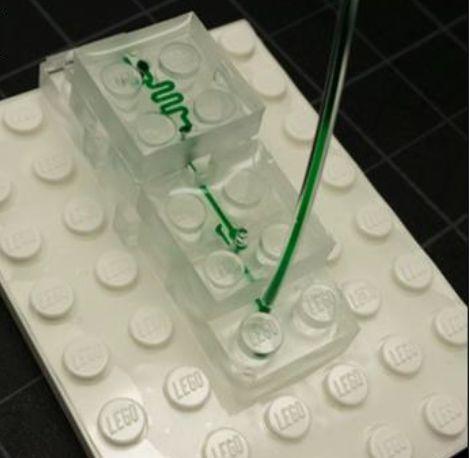 A few weeks ago, researchers from the Department of Biomedical Engineering at the University of California, Irvine, introduced a paper focusing on an innovative Lego-based modular microfluidics platform designed with 3D printed molds.
A few weeks ago, researchers from the Department of Biomedical Engineering at the University of California, Irvine, introduced a paper focusing on an innovative Lego-based modular microfluidics platform designed with 3D printed molds.
Complex microfluidics platforms and microfluidics technology in general serve as the foundation of important and sophisticated research in the fields of medicine, health care, clinical diagnostics and drug discovery. In the area of biology in particular, microfluidics platforms have helped researchers understand and analyze highly sensitive bioanalytical systems.
The advancement in microfluidic technology has been allowing researchers to demonstrate immense progress on various studies such as stem cell research by offering a more systematic method of evaluating stem cells.
“Microfluidics systems have a wide range of applications, including point of care diagnostics; ‘smart’ nanomedicine for early detection and treatment; tissue engineering and stem cells; and biosensors to detect environmental and terrorism threats. In point of care testing, for example, microfluidics enables the detection of highly dilute compounds, such as rare, blood-borne cancer cells or bacteria. In addition, the miniaturisation enables microfluidic devices smaller than quarters,” said Abraham Lee, principal investigator at University of California, Irvine’s Biomolecular Microsystems and Nano Transducers (BioMINT) Lab.
However, one major limitation of microfluidics technology is its complexity and its incompatibility to most research initiatives. Microfluidics platforms aren’t readily available and accessible to researchers and often require a significant amount of labor and resources in order to expand applicability.
To provide an alternative solution to researchers attempting to utilize microfluidics technology, Lee and former UCI undergraduate Kevin Vittayarukskul led a study which actively looked into the usability of LEGO interlocking plastic blocks and 3D printed molds to create microfluidics platforms that demonstrate higher levels of alignment accuracy, 3D printing dimension and burst pressure. Their results are published in a paper entitled “A truly Lego-like modular microfluidics platform” in the Journal of Micromechanics and Microengineering.
“In this paper, a truly Lego-like microfluidics platform is introduced, and its basic feasibility is demonstrated. Here, PDMS building blocks resembling 2 × 2 Lego bricks are cast from 3D-printed master molds. The blocks are pegged and stacked on a traditional Lego plate to create simple, 3D microfluidic networks, such as a single basket weave,” the paper’s abstract states.
By relying on the precision and accuracy of 3D printing, Lee, Vittayarukskul and their team of researchers created LEGO-style microfluidics platforms that are more accessible in terms of fabrication and assembly.
“A typical microfluidic device is like a piping network, except the pipes have diameters in the submillimeter range. Our modular system, based on the design of LEGO bricks, allows cheaper and simpler construction of such devices compared to the more traditional fabrication methods like 3D printing or photolithography,” said Vittayarukskul said.
Lee explained that the system developed by his team of researchers aims in providing researchers in across many fields and industries a way to utilize microfluidics platforms with ease by creating custom-designed 3D microfluidic devices. The key of Lee’s microfluidics system is that the assembly of the platform is as simple as putting LEGO blocks together.
“Despite its potential, microfluidics remains a fairly niche area because of the difficulty in fabrication and assembly. Our system means the creation of custom, 3D microfluidic devices is really as simple as assembling traditional LEGO blocks. The design is simple, usable, and promotes mass production. We hope these features will encourage a broader range of researchers to adopt the technology and explore the possibilities it offers,” said Lee.
Previously, 3DPrint.com reported that Lawrence Livermore National Laboratory and Giant Leap Technologies received a grant from the United States Department of Energy to develop 3D printed microfluidic solar power collectors.
With companies like Giant Leap Technologies and researchers such as Lee, 3D printing technology’s potential within the niche field of microfluidics is becoming unlocked and exploited by an increasing number of researchers. Discuss in the UC Irvine forum at 3DPB.com.
[Source: IOP Publishing]
Subscribe to Our Email Newsletter
Stay up-to-date on all the latest news from the 3D printing industry and receive information and offers from third party vendors.
You May Also Like
NSF Awards Kentucky $1M for Advanced Manufacturing
The National Science Foundation has awarded a $1 million grant to the University of Louisville for the Advancing Manufacturing and Building Construction Technologies (NSF AMT) project. This initiative is part...
3D Printing News Briefs, May 11, 2024: 3D Printed Stent, Tower, Sculptures, & More
We’re starting off with medical research in today’s 3D Printing News Briefs, as researchers in Korea used CT images and 3D printing to fabricate an educational simulator for a mastoidectomy....
3D Printing Unpeeled: Wind Turbines, Probiotics and Lenses
TPI Composites, ORNL and Ingersoll Rand are working to make wind turbine tooling segments that can be 18.3 meters long. These elements also include resistive wires that help keep the...
Tethon 3D Releases Cost-effective Bioprinter
Tethon 3D, known for its ceramic-loaded DLP materials, custom resins, and DLP 3D printers, has recently released a bioprinter. Vat polymerization printers like DLP systems have been widely used by...


































